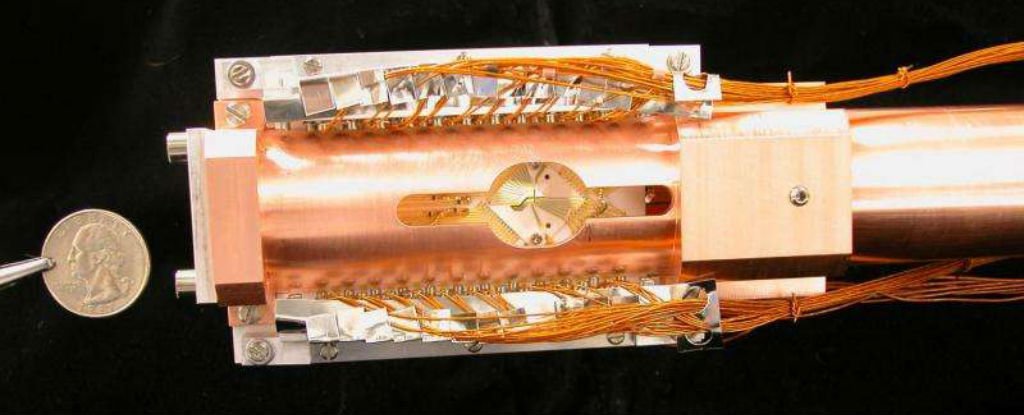
As conventional computers draw ever closer to their theoretical limit, the race is on to build a machine that can truly harness the unprecedented processing power of quantum computing. And now two research teams have independently demonstrated how entangling atoms from different elements can address the problem of quantum memory errors while functioning within a logic gate framework, and also pass the all-important test of true entanglement.
"Hybrid quantum computers allow the unique advantages of different types of quantum systems to be exploited together in a single platform," said lead author Ting Rei Tan. "Each ion species is unique, and certain ones are better suited for certain tasks such as memory storage, while others are more suited to provide interconnects for data transfer between remote systems."
In the computers we use today, data is processed and stored as binary bits, with each individual bit taking on a state of either 0 or 1. Because these states are set, there’s a finite amount of information that can ultimately be processed, and we’re quickly approaching the point where this isn’t going to be enough.
Quantum computers, on the other hand, store data as qubits, which can be in the state of 0 or 1, or can take on another state called superposition, which allows them to be both 0 and 1 at the same time. If we can figure out how to build a machine that integrates this phenomenon with data-processing capabilities, we’re looking at computers that are hundreds of millions of times faster than the super computers of today.
The qubits used in this set-up are actually atomic ions (atoms with an electron removed), and their states are determined by their spin - spin up is 1, spin down is 0. Each atomic ion is paired off, and if the control ion takes on the state of superposition, it will become entangled with its partner, so anything you do to one ion will affect the other.
This can pose problems, particularly when it comes to memory, and there’s no point storing and processing information if you can’t reliably retain it. If you’ve got an entire system built on pairs of the same atomic ions, you leave yourself open to constant errors, because if one ion is affected by a malfunction, this will also affect its partner. At the same time, using the same atomic ions in a pair makes it very difficult for them to perform separate functions.
So researchers from the University of Oxford in the UK, and a second team from the National Institute of Standards and Technology (NIST) and the University of Washington, have figured out which combinations of different elements can function together as pairs in a quantum set-up.
"Each trapped ion is used to represent one ‘quantum bit’ of information. The quantum states of the ions are controlled with laser pulses of precise frequency and duration," says one of the researchers, David Lucas from the University of Oxford. "Two different species of ion are needed in the computer: one to store information, a 'memory qubit', and one to link different parts of the computer together via photons, an 'interface qubit'."
While the Oxford team achieved this using two different isotopes of calcium (the abundant isotope calcium-40 and the rare isotope calcium-43), the second team went even further by pairing up entirely different atoms - magnesium and beryllium. Each one is sensitive to a different wavelength of light, which means zapping one with a laser pulse to control its function won’t affect its partner.
The teams them went on to demonstrate for the first time that these pairs could have their 0,1, or superposition states controlled by two different types of logic gates, called the CNOT gate and the SWAP gate. Logic gates are crucial components of any digital circuit, because they’re able to record two input values and provide a new output based on programmed logic.
"A CNOT gate flips the second (target) qubit if the first (control) qubit is a 1; if it is a 0, the target bit is unchanged," the NIST press release explains. "If the control qubit is in a superposition, the ions become entangled. A SWAP gate interchanges the qubit states, including superpositions."
The Oxford team demonstrated ion pairing in this set-up for about 60 seconds, while the NIST/Washington team managed to keep theirs entangled for 1.5 seconds. That doesn’t sound like much, but that's relatively stable when it comes to qubits.
"Both teams confirm that their two atoms are entangled with a very high probability; 0.998 for one, 0.979 for the other (of a maximum of one)," John Timmer reports for Ars Technica. "The NIST team even showed that it could track the beryllium atom as it changed state by observing the state of the magnesium atom."
Further, both teams were able to successfully perform a Bell test by using the logic gate to entangle the pairs of different-species ions, and then manipulating and measuring them independently.
"[W]e show that quantum logic gates between different isotopic species are possible, can be driven by a relatively simple laser system, and can work with precision beyond the so-called 'fault-tolerant threshold' precision of approximately 99 percent - the precision necessary to implement the techniques of quantum error correction, without which a quantum computer of useful size cannot be built," said Lucas in an Oxford press release.
Of course, we don't have proper quantum computers to actually test these components in the context of a functioning system - that will have to be the next step, and international teams of scientists and engineers are racing to get us there. We can't wait to see it when they do.
Read these next:
BEC CREW
18 DEC 2015
Niciun comentariu:
Trimiteți un comentariu